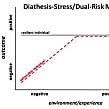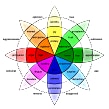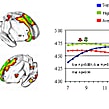Maslow’s eight basic needs and the eight stage developmental model
Most of us are familiar with the Maslow’s hierarchy of needs
. Though we tend to think of them as five basic needs, Maslow had
modified the hierarchy later to include three other needs at the top
taking the total to eight. The modified diagram is given below.

Out of these, the first four needs, Maslow identified as deficit needs: i.e if the needs are not met, they make us uncomfortable and we are motivated or driven by these needs in as much as we are able to sufficiently fulfill these needs.
The last four needs, he identifies as growth needs: i.e. we never get enough of these . We are constantly motivated by these needs as they pertain to our growth and development.
He also arranged them in a hierarchy such that we are motivated primarily by a need only if lower level needs have been met. Thus, before one is motivated by cognitive or self actualization needs, one should have taken care of basic deficit needs like physiological, security, belonging and esteem.
Now, everyone knows I am sold to the eight stage developmental model. As such I see clear parallels here between developmental tasks that are achieved and needs that are met.
Let me now present the eight Maslow needs and explain it using analogies form other eight stage models.
- Physiological needs: These are the basic animal needs for such things as food, warmth, shelter, sex, water, and other body needs. If a person is hungry or thirsty or his body is chemically unbalanced, all of his energies turn toward remedying these deficiencies, and other needs remain inactive. If one’s basic biological needs are not met, one would never be able to trust the environment and would be stuck with high neuroticism and anxiety.
- Safety needs:With his physical needs relatively satisfied, the individual’s safety needs take over and dominate his behavior. These needs have to do with man’s yearning for a predictable, orderly world in which injustice and inconsistency are under control, the familiar frequent, and the unfamiliar rare. This need for consistency, if not satisfied leads to feelings of doubt and shame (as opposed to feelings of autonomy or being in control) and lead to high conscientiousness or need for discipline and orderliness.
- Belonging needs:After physiological and safety needs are fulfilled, the third layer of human needs is social. This psychological aspect of Maslow’s hierarchy involves emotionally-based relationships in general, such as friendship, sexual intimacy and having a supportive and communicative family. If one finds failure in having such close relationships, one is bedeviled with such negative social emotions like guilt (vis a vis initiative) and has low extraversion values.
- Self-esteem needs: All humans have a need to be respected, to have self-esteem, self-respect, and to respect others. People need to engage themselves to gain recognition and have an activity or activities that give the person a sense of contribution, to feel accepted and self-valued, be it in a profession or hobby. This need if not satisfied leads to feelings of inferiority vis-a-vis feelings of industry. Feelings of inferiority in turn may lead to low agreeableness.
- Cognitive needs:Maslow believed that humans have the need to increase their intelligence and thereby chase knowledge. Cognitive needs is the expression of the natural human need to learn, explore, discover and create to get a better understanding of the world around them.This growth need for self-actualization and learning, when not fulfilled leads to confusion and identity crisis. Also, this is directly related to need to explore or the openness to experience.
- Aesthetic needs: Based on Maslow’s beliefs, it is stated in the hierarchy that humans need beautiful imagery or something new and aesthetically pleasing to continue up towards Self-Actualization. Humans need to refresh themselves in the presence and beauty of nature while carefully absorbing and observing their surroundings to extract the beauty that the world has to offer. This need is a higher level need to relate in a beautiful way with the environment and leads to the beautiful feeling of intimacy with nature and everything beautiful.
- Self-actualization needs: Self-actualization is the instinctual need of humans to make the most of their abilities and to strive to be the best they can.This need when fulfilled leads to feeling of generativity.
- Self-transcendence needs: Maslow later divided the top of the triangle to add self-transcendence which is also sometimes referred to as spiritual needs. Spiritual Needs are a little different from other needs, accessible from many level. This need when fulfilled, leads to feelings of integrity and take things to another level of being.
I, as usual, am quite excited by these parallels and implore my readers to explore this further. In my next post I will be taking about core social motives theory, which like Maslow’s is a needs theory, and how that maps to the five initial stages of development.
Effecient Related Posts:
Comments Closed
6 Responses to “Maslow’s eight basic needs and the eight stage developmental model”
Additional comments powered by BackType







Dear Sandy G, Thanks for making me aware of Maslow’s eight basic needs; a few of which can easily be subsumed under one, though.
I am a first year PhD at Manchester University (UK) you can look me up on the Russian department. Florian.Weinhold@postgrad.manchester.ac.uk
In the course of my first few months here, I started getting involved with issues of identity/identification, selfhood; the self-other, other-self, as it were. They are intrinsically connected with basic needs and more. Unfortunately, my supervisors do not let me proceed with this project; it’s deemed irrelevant. I am looking for somebody to work on a unifying framework for identification, which should be fairly short, actually. Perhaps 60-150 A4 pages. But I would need somebody with the right background and possibility to publish the whole thing later. If you or any other reader here are seriously interested – please, you need to have some qualification and not be opposed to interdisciplinary approaches (psychology, sociology, cognitive linguistics, perhaps some philosophy of language, mind and history) – I am looking for primarily moral and institutional support, but am not loath to share the “laurels” nor to taking advice.
Dear Bambolo,
Thanks for reading the blog and commenting. I have replied directly to you on the email provided, regarding collaborative work, but for the sake of other readers, let me also clarify here.
I am very much interested in collaborative work and in getting some papers published, but I lack university affiliation; as such I can only contribute as independent researcher. If someone still wants to collaborate , I would be really excited and grateful.
[…] written previously about Maslow’s motivational hierarchy and how that relates to the eight stage evo-devo model. […]
[…] Maslow’s eight basic needs and the eight stage devlopmental model | The Mouse Trap By Wes Phillips On April 28, 2011 · Leave a Comment Maslow’s eight basic needs and the eight stage devlopmental model | The Mouse Trap. […]
A really very fruitful blog..
Interesting attempt to blend Maslow and Erikson. That kind of synthesizing always intrigues me.
I have long thought about the fundamental human needs and how to categorize and understand them. I’ve also thought a lot about how they influence relationships and the modern condition.
You might find my page about human needs interesting to get my take on it. I also synthesize a variety of different fields.
Thanks for this piece.